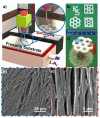Aerogels for Biomedical, Energy and Sensing Applications
- PMID: 34940324
- PMCID: PMC8701306
- DOI: 10.3390/gels7040264
Aerogels for Biomedical, Energy and Sensing Applications
Abstract
The term aerogel is used for unique solid-state structures composed of three-dimensional (3D) interconnected networks filled with a huge amount of air. These air-filled pores enhance the physicochemical properties and the structural characteristics in macroscale as well as integrate typical characteristics of aerogels, e.g., low density, high porosity and some specific properties of their constituents. These characteristics equip aerogels for highly sensitive and highly selective sensing and energy materials, e.g., biosensors, gas sensors, pressure and strain sensors, supercapacitors, catalysts and ion batteries, etc. In recent years, considerable research efforts are devoted towards the applications of aerogels and promising results have been achieved and reported. In this thematic issue, ground-breaking and recent advances in the field of biomedical, energy and sensing are presented and discussed in detail. In addition, some other perspectives and recent challenges for the synthesis of high performance and low-cost aerogels and their applications are also summarized.
Keywords: aerogels; catalysts; porous materials; sensors; silica aerogels.
Conflict of interest statement
The authors declare no conflict of interest.
Figures








References
-
- Kurundawade S.R., Malladi R.S., Kulkarni R.M., Khan A.A.P. Advances in Aerogel Composites for Environmental Remediation. Elsevier; Amsterdam, The Netherlands: 2021. Natural aerogels for pollutant removal; pp. 19–32.
-
- Liu H., Du H., Zheng T., Xu T., Liu K., Ji X., Zhang X., Si C. Recent progress in cellulose based composite foams and aerogels for advanced energy storage devices. Chem. Eng. J. 2021;426:130817. doi: 10.1016/j.cej.2021.130817. - DOI
-
- Ashraf M.A., Wiener J., Farooq A., Saskova J., Noman M.T. Development of maghemite glass fibre nanocomposite for adsorptive removal of methylene blue. Fibers Polym. 2018;19:1735–1746. doi: 10.1007/s12221-018-8264-2. - DOI
-
- Yang M., Choy K.-l. A nature-derived, flexible and three dimensional (3D) nano-composite for chronic wounds pH monitoring. Mater. Lett. 2021;288:129335. doi: 10.1016/j.matlet.2021.129335. - DOI
Publication types
Grants and funding
LinkOut - more resources
Full Text Sources
Other Literature Sources

